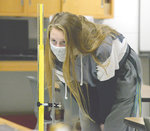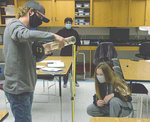Cloudy and Windy, 58° F
Educating college students during a pandemic is challenging, to say the least.
In the spring, the faculty of Northwest College got a crash course in conducting classes in an online format, when …
This item is available in full to subscribers.
The Powell Tribune has expanded its online content. To continue reading, you will need to either log in to your subscriber account, or purchase a subscription.
If you are a current print subscriber, you can set up a free web account by clicking here.
If you already have a web account, but need to reset it, you can do so by clicking here.
If you would like to purchase a subscription click here.
Please log in to continue |
|


Educating college students during a pandemic is challenging, to say the least.
In the spring, the faculty of Northwest College got a crash course in conducting classes in an online format, when the school transitioned to a full online learning model in a matter of two weeks.
“It was a difficult transition to make, because it was so unexpected,” recalled Deepthi Amarasuriya, assistant professor of physics.
College personnel pulled it off, and all the students enrolled at NWC had the opportunity to complete the semester. Aside from some nursing clinicals, which had to be done face-to-face, the instructors managed to transition all classes to an online format. Through the spring and summer semester, they worked out a few kinks.
Learning to teach
This fall semester brought a new challenge when the college began offering hybrid classes, which deliver as much online instruction as possible and then conduct labs in-person, with health protocols. That includes masks and keeping 6 feet apart.
The protocols can be a challenge in a lab since an instructor provides students with more than hands-on learning; the exercises are often meant to be collaborative.
“We reduced the number of students that can be in the lab so we can have a 6 foot distance,” said Garry Wallace, assistant professor of biological sciences. “But when you’re in the lab, you can’t keep the 6-foot distance, because it’s a lab.”
Wallace said that, aside from a few exceptions involving students who weren’t in his class, his own students have been compliant with the protocols, which he repeats at the start of every lab.
However, there are situations where students will be looking in a microscope and he needs to see what they’re looking at. So, the student has to move 6 feet away before Wallace can look in it.
It’s the same thing when students in anatomy classes are performing dissections; Wallace can’t just walk up and examine their specimen while they work.
The professor said he had one student who recently tested positive for COVID-19. The student was in the lab where they were moving around from table to table. Fortunately, there were only about six students in the classroom, they were all masked up and Wallace had them seated one to a table.
NWC’s fall classes were designed so that all the face-to-face work would be done by Thanksgiving break. The goal was to cram all that lab work into the front of the semester, and if a surge forced the college to close campus later on, all the classes could go virtual.
Besides the positive case, Wallace had another student who is on military duty in Montana. The student was in contact with a confirmed case and has had to quarantine. Wallace decided to cancel the last lab before Thanksgiving.
Fortunately, he had that option. Next semester he’s going to take a few more precautions when conducting his lab, such as designing them to reduce close interaction between students.
“It’s kind of a moving target how to deal with this,” Wallace said.
Being prepared
Astrid Northrup, professor of engineering and mathematics, teaches a surveying course in the spring. One of the reasons NWC was able to transition to entirely online classes this spring was because the students had a lot of time to do the lab work before the pandemic swept through the country.
“I taught them some really fundamental skills, and then we could just build on those skills,” Northrup remembered.
She’s designing this coming spring’s class to get the students together in a lab for two or three days of lab work right at the start, where they’ll learn the “nuts and bolts” of surveying. Then, if the class has to go online, the students can still complete the semester.
Northrup said she can maintain the needed health protocols in the lab; she and the students can wear masks and keep 6 feet apart. However they will use the same eyepiece, which could theoretically spread the virus between students. So, she’ll have them wipe down the tool with anti-bacterial wipes before another student looks through it.
Northrup said the welding classes were also prepared for a shutdown this semester. They had portable and virtual welders ready for students to use at home if it came to that. Fortunately, the classes were able to finish up the hands-on instruction before Thanksgiving.
“It’s all about being prepared. It’s like we’re the Boy Scouts,” Northrup said.
Eric Atkinson, associate professor of biology, learned at least one thing that will help provide better labs next semester. This fall, they held the labs every other week to space out the number of students in the class at one time. The problem is that sometimes the online lectures outpace the lab.
“Sometimes you had the cart before the horse and vice versa,” Atkinson said.
Next semester, he’s going to do two labs back-to-back on the same day, rather than break them up into two weeks.
“I think it’ll build our engagement much better,” Atkinson said.
Other challenges
Even though they’ve made it work and students have been compliant with the protocols, the instructors say it’s not really ideal.
“When you’re teaching in a face-to-face class, you can have multiple things up,” Amarasuriya, the physics professor, said. “You can have your Powerpoint up, the students have their notes in front of them. And you can say, look at this, look at this.”
On Zoom, she can only show one thing at a time.
“It takes time. It’s just inconvenient,” she said.
Atkinson said the online format creates a barrier to building the rapport he seeks from his students.
“Even when I lecture, even in general biology, I like my lectures to be very interactive and discussionary,” he explained.
Last spring, Atkinson had time to build that trust with his students before the campus was shut down. This year, he’s had to try to do that online. Atkinson finally built that trusting relationship with the students, he said, but it was a slower process.
Amarasuriya said the masks also make it difficult to teach in person. She watches students’ expressions to determine who is grasping the material, who is fully engaged, and who might be confused. The masks hide a lot of that.
“Those visual cues are not there,” the physics professor said. “I’m always looking at the students’ faces, to gauge if they look puzzled or [are] catching on.”
Originally from Sri Lanka, English is not Amarasuriya’s first language and she speaks with an accent. The masks sometimes make it more difficult for her students to understand her.
Northrup has tried to work around some of these issues by giving students her cell number. She tells them to text her anytime, as she shuts off her phone at night so they can’t wake her. She said they really utilize the option and she can sometimes get dozens of texts a day, which maintains regular interaction with her students.
“It’s like a personal relationship,” Northrup said.
Improving their game
Online learning is not all impediments. Northrup points out that some students are shier than others and would, in the face-to-face classroom, be less engaged.
“Sometimes the quieter people don’t feel comfortable. If they can do a one-on-one on Zoom or they can text you, I think I get a lot of communication from a broader array of students,” Northrup said.
Atkinson has found the same benefit for the quieter students, who might not speak but will use Zoom’s chat function to type their comments and questions during the lecture.
He also found that some students just take to the online communications better than others. Atkinson teaches GIS — geographical information systems, which is used in complex mapping — and found students tend to learn easily in the Zoom format.
Perhaps it’s because students with an interest in GIS are going to be comfortable working with computers — some are drafting students, which uses a lot of software — and Atkinson said it might be because they are non-traditional, older students who are often working professionals developing new skills.
Another benefit of the online classroom is that, living in Belfry, Montana, Atkinson sometimes gets snowed in. Now if that happens, he’ll just email his students that the lecture will be online and he doesn’t lose a week of instruction.
With all of the challenges of teaching in this kind of environment, Atkinson said new tools are being developed. Companies are developing more virtual labs, such as an app that runs on the students’ phones and allows them to look at sea turtle populations.
“There are a lot of opportunities, and yeah, they don’t substitute for one-on-one or face-to-face, but it’s not like we’re standing still,” he said. “I feel that we’re able to meet most of our students’ educational needs.”
Northrup praises NWC’s handling of the pandemic. She said that the University of Wyoming didn’t handle the crisis poorly, but they had a lot of changes throughout the semester over what was open and what wasn’t. Dorms got shut down unexpectedly, and a number of other plans had to be altered through this fall semester.
“In my opinion, Northwest College handled this whole thing brilliantly,” Northrup said. “I wasn’t directly involved in this, so I’m bragging about my institution and not myself. But we developed a plan and that was the plan. We didn’t pull our students back and forth.”
As instructors in a pandemic, the NWC faculty is figuring out how to teach in this very strange time in our history. And Northrup said they’ll continue to weather the storm.
“We gave our students a way forward. And we’ll do it again in the spring,” she said. “Whatever it takes.”